You don’t have to have an in-depth understanding of wine to have a home tasting, basic knowledge is enough. But it is important that the topic is interesting not only to the person organizing the party but also to his friends. If people are interested in wine, hosting a home tasting will be more interesting than just sitting around, chatting, and drinking.
Preparing
The optimal number of participants for a tasting is 5 to 10 people. Plan in advance where the tasting will take place, and prepare the venue. If the weather permits, an outdoor tasting is a great option. But don’t forget that the wine needs to be kept in the shade as well as the tasting. Put a large tent and don’t forget about comfortable furniture to create the best possible atmosphere. We advise you to pay attention to rattan furniture to give the impression of a wine siesta in Italy. The best outdoor furniture in Dubai can come in handy for this purpose.
You need a minimum of three different bottles of wine, less makes no sense. A good option is if you agree in advance with friends that each will bring one bottle to the tasting. The wines should be about the same age and in the same price range.
For a ‘blind’ tasting, bottles should be wrapped in foil or wrapped in paper bags so that no one sees the label and doesn’t know in advance what they are tasting. Samples should also be numbered so they don’t get confused.
Which wine to choose
It is better not to mix red and white wines in one tasting, as it is more difficult to sort out the taste. One suggestion is you use sparkling wines.
For a simple ‘blind’ tasting, it’s best to choose wines that are different from each other, for example you can compare Champagne and Prosecco to other sparkling wines and enjoy the bubbles. If you’re gathering people who know a lot about wine, you can make it harder for them and offer similar wines for comparison, such as a vintage Champagne or traditional method sparkling wines from different countries.
Another option is to move away from the ‘blind’ tasting and simply taste several wines from the same grape variety from different producers in an evening, such as comparing well known Champagnes with grower Champagnes. Or compare wines from the same country or region — for example, try different sparkling wines from Italy regions with Prosecco, Franciacorta and TrentoDoc.
The tasting portion should be very small — 50-70 ml. This is just to make sure that you don’t get too drunk by the end of the tasting. For the same, you need an appetizer, but the simplest, which will not interrupt the taste of the wine: bread and cheese — without the noble mold and not very salty. Spicy, salty, or tangy food strongly affects the taste of the wine and changes its perception.
Risks
• The tasting experience can be blurred by not knowing a few important things. Firstly, it’s a good idea to drink a glass of water after each wine and rinse it so the flavors don’t mix.
• The second important point is that all the glasses must be the same shape. The shape of the glass greatly affects the aroma, so if everyone drinks from different glasses, then everyone’s impression of the wine will be different.
• Thirdly, the wine should be of the right temperature. Sparkling wines are best served between 8-12°C
Conclusion
I’m sure the idea of entertaining everyone with a tasting will satisfy everyone’s needs. Just do not take everything too seriously, make it fun. Meeting like this more often, because it’s all about the quantity turning into quality and it’s all about gaining a deeper understanding of wine.
So what exactly does Methode Cap Classique (MCC) mean?
“Methode Cap Classique (MCC) is the name used to refer to South African sparkling wines made by the traditional method. The term was adopted in 1992 in response to the ban on the use of the words ‘Champagne’ and ‘Champenoise’ for anything other than the bottle-fermented wine from the Champagne region in France. MCC are considered a premium category in South Africa and the term ‘Methode Cap Classique’ will always be written on the label to represent their classification.” glassofbubbly
Made in the same way that Champagne is, and also Franciacorta / English Sparkling Wine / Cava / Cremant and more, South African sparkling wines offer great depth of flavours thanks to their terroir (influences of Atlantic & Indian oceans) and grape varieties including Chenin Blanc (most commonly grown), Pinot Noir, Chardonnay, Pinot Meunier. Sparkling wine is also produced according to the Charmat method and, very recently, a few wines have been made in the Méthode Ancestrale.
“South Africa has approximately 100,000 hectares of vineyards which is more or less the same as the area of the Bordeaux wine region of France.“
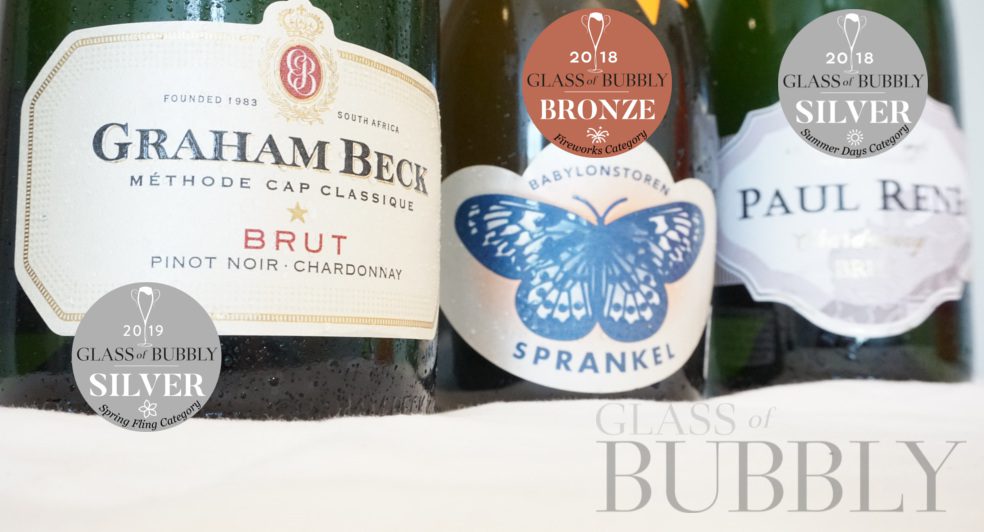
Graham Beck – Babylonstoren – Paul Dene
What does Methode Cap Classique – South African Sparkling Wine taste like?
Graham Beck – NV Brut: “Creamy green fruits and yellow floral on the nose. Fresh and fruity style. Good balance between acidity and sweetness in the palate – floral, apricot, peach skin, touch of herbaceous and a soft citrus close.”
Babylonstoren – Sprankel 2013: “Crisp red apples and pastry on the nose. A dry flavour of yeasty, minerals, bruised green apples.”
Paul Rene – Brut: “Zesty cirtus and apple aromas with added white floral and brioche notes. Flavours are young and vibrant with a fresh fruity taste sensation showing yellow stone fruits, lemon zest, flaky pastry, toast, freshly cut grass, white floral. Quite a bit packed into a single glass of bubbly!”
]]>
Today I want to put them to the test, are they a novelty product or do they really deliver on an enhanced Cocktail experience?
The Salty Rim Co. was founded by husband and wife team, David & Victoria, two lovers of cocktails, wanting to add to the ultimate experience by creating something tasty and entertaining.

The Cocktails
Now let’s get down to the fun part, I’ve picked out two of their rims to experiment with, their Bronze Dust and their special Santa Baby Sugar, both Cocktails consisted of the same Franciacorta, Italian Sparkling Wine made using the Classic (Champagne) Method, the Bronze Dust also included Ratafia and the Santa Baby included Cherry Juice

Bronze Dust – The bronze dust complements the Franciacorta very nicely, along with the honey flavours coming through from the rim, the honey adds an extra sweetness from the already sweetish Franciacorta, the Ratafia with its prunes in syrup and faint oak flavours works nicely when combined with the bronze dust which has a sweetness to it, but more on an expensive delicate bite-size treat level.
Santa Baby – Cherry Juice, Sparkling Wine and this new Santa Baby sugar rim come together and creates a festive vibe which makes me think of Christmas, the fizzy cherry Juice which is already sweet in flavour, combined with the candy-cane flavour from the Santa Baby sugar rim, create a really nice afternoon cocktail to enjoy with family and friends around an open fire opening presents.
The flavours of the Sugar Rims worked really well with the Cocktails, they bestowed new flavours and enhanced some existing ones, although they have great style points, they also add to the overall tasting experience and for that reason, I look forward to using them again for future Cocktails, I am very satisfied with the quality of Salted Rim and look forward to what they deliver in the future.
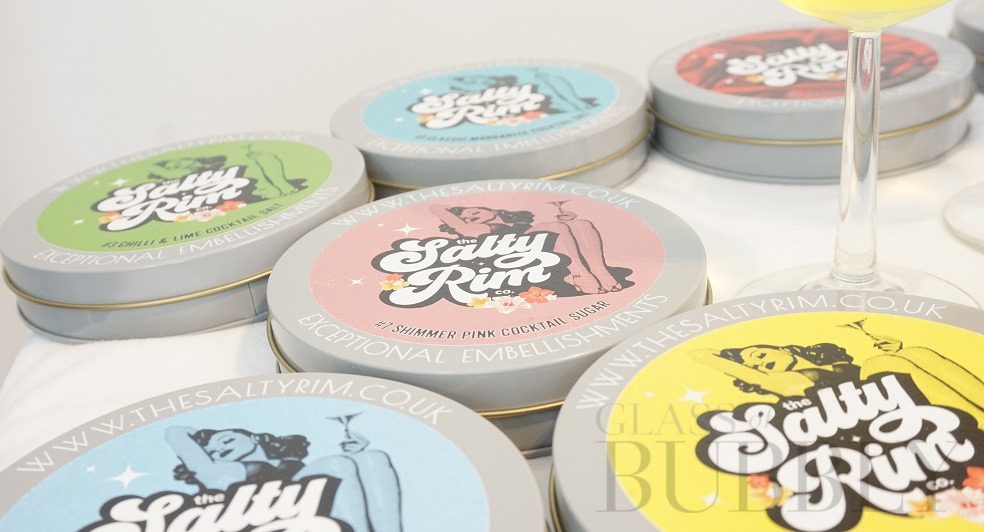
The Salted Rim Collection:
#1 Classic Margarita Cocktail Slat
#2 Citrus Cocktail Slat
#3 Chilli & Lime Cocktail Salt
#4 Bloody Mary Brim Trim
#5 Best Of British Cocktail Sugar
#6 Mint Cocktail Sugar
#7 Summer Pink Cocktail Sugar
#8 Summer Blue Cocktail Sugar
#9 Brazen Red Cocktail Sugar
#10 Sunshine Yellow Cocktail Sugar
#11 Bronze Cocktail Dust
#12 Santa Baby Cocktail Sugar
Each tin contains 100g of sugar, salt, or dust and each tin also comes with a coaster for you to place your Cocktail on, I thought this was a nice touch and a welcome bonus. Each tin will cost you £9.99 and if you buy 3 or more, you get free shipping, for the price.
I am glad that these Sugar, Salt and Dust rims from Salted Rim have been brought to market, it is a great business idea to package unique flavours to be able to add an extra touch to your Cocktails, each tin delivers on their flavours perfectly, they will have 12 flavours available to purchase very soon, and hopefully even more next year, the more flavours they create the better, they have some classics like Margarita and Bloody Mary, some simple ones like Citrus and Mint which many people will enjoy and some creative ones like Best Of British and Santa Baby which go outside the box and that’s where I think they can really thrive, the more unique flavours they create, the more I’ll be returning to see how I can expand my Cocktail making ingredients.
]]>If you are seeking an Italian fizz to brighten your mood, then Franciacorta would satisfy your highest expectations: sparkling like diamonds, charismatic and lively will dazzle you with its unique appeal.
The cultivation of vines has ancient origins on the hills of Franciacorta, as evidenced by the findings of prehistoric grape seed and the writings of classical authors such as Pliny and Virgil.
The area known as Franciacorta lies in the heart of Lombardy bordering Lake Iseo. It’s approximately 200 square kilometres and includes 19 municipalities in the province of Brescia.
The morainic origin of this area gives the soil an extraordinarily rich mineral content that, along with the variety of its components, determines the key factors for high quality viticulture, which can be fully appreciated in the sensorial aspects of every Franciacorta.
Alongside the production of Franciacorta DOCG in different varieties such as Rosè, Millesimato and Riserva this land provides an exclusive sparkling wine called Franciacorta Satèn made from a blend of Chardonnay and Pinot blanc up to a maximum of 50%
History
Vine cultivation has been a constant in Franciacorta area, where grapes were grown from Roman times to late antiquity and the Middle Ages, thanks to its favourable climatic and soil conditions. Though it experienced good and bad periods alike, viticulture in these lands never stopped.
The history of Franciacorta is strongly tied the presence of large monastic institutions. Even before the year 1000, they had large estates and carried out large-scale work, clearing, reclaiming and cultivating the land.
The first document to mention property located in Franciacorta, which belonged to the monastery of San Salvatore in Brescia, dates from the year 766. It is the diploma by which Adelchi, son of Desiderius, donated all the goods he had inherited from his grandfather Verissimo and his uncles Donnolo and Adelchi to the monastery, including some assets from this area.
Grapes
The grapes used for making Franciacorta DOCG are primarily of the Chardonnay variety, a very highly valued white-skinned variety, has been grown in Franciacorta for several decades and currently covers over 2300 hectars of vineyards, which corresponds to approximately 80% of the total area. Pinot noir, is the second most widespread vine in Franciacorta and occupies about 15% of the total area. Pinot blanc, is the third most popular vine in Franciacorta, it is of French origin and belongs to the large family of Pinot. It now occupies about 5% of the total area.
Franciacorta DOCG live tasting
View this post on Instagram
Mirabella Brut Satèn Franciacorta
Delicate and brilliant with lively perlage. Fruity character with notes of exotic fruits, pineapple and touch of hazelnut. Pleasant freshness, zesty, soft and well-balanced.
Castello Bonomi Franciacorta Dosage Zero Millesimato 2011
Pinot Nero 50% and Chardonnay 50%
Straw deep yellow colour with a lively mousse. Notes of citrus and vanilla, intense notes of pastry, bread crust and almond.
On the palate, it is round and full, mellow and dry.
La Montina Franciacorta Rosè Extra Brut
Pinot Nero 85% and Chardonnay 15%
Pink brillant colour, vibrant and long-lasting perlage. Toasty character, hints of berries and ripe fruit, on the palate it is mellow, crisp with a good body.
Franciacorta DOCG food pairing
It is the perferct fizz suitable for any important occasions: from an aperitif to main dishes, from the simplest meal to the most complex. I would suggest the following food pairing wih each of these Franciacorta DOCG due to its content of sugar.
Satèn Brut: utterly divine if paired with raw fish, lobster and crab cakes, or more complex dishes such as rigatoni with sea urchin or second dishes like scallops with purple potatoes and almonds.
Pas dosè: pike salad with fresh fennel, fish dishes like pasta with clams and pachino tomatoes, second dishes such as monkfish with pistachio, hazelnuts and capers.
Rosè Extra Brut: perfect with risotto with prawns, spaghetti with red mullet and wild fennel, tuna tartare. Roast chicken with crisp vegetables, spiny lobster alla catalana.
Find Stefania on Instagram:
]]>Welcome to the Italian Rosé Line Up, showcasing some award-winning rosé’s from Italy, each has their own character, each unique in its own way, but one thing does combine them all, they all want to be popped open and enjoyed, so let’s get into it.
1 Maso Martis
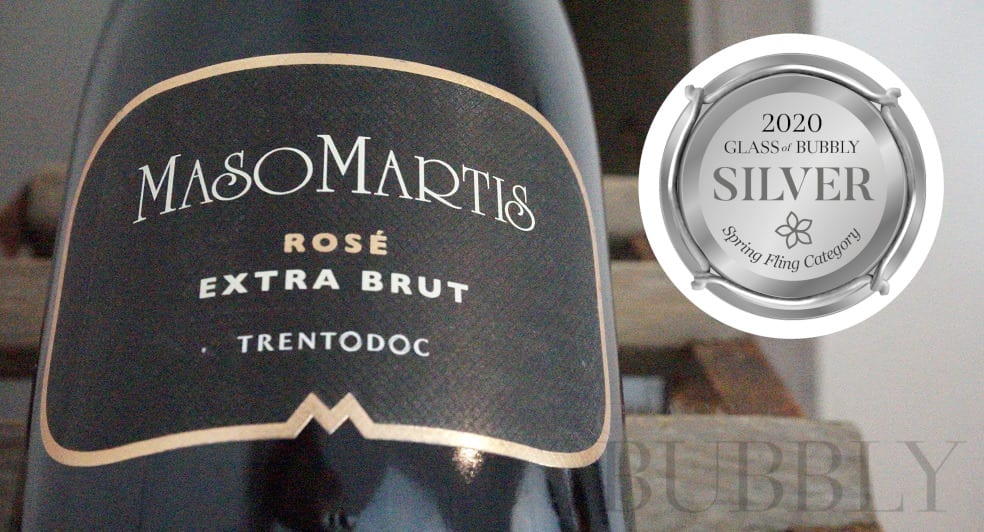
The story of Maso Martis began in 1990, a few years before the birth of their two daughters Alessandra and Maddalena, when they bought their farm, they started producing their Sparkling Wine before the TrentoDOC brand had really taken off.
They live in a house located in the heart of their vineyards, and for over 30 years the family has been putting their love and passion into making their Sparkling Wines, with 6 bottles to choose from, your sure to find one that you like.
Maso Martis – Rosé Extra Brut 2016 Tasting Notes
Aromas – “ Toasty, herbal and red berries on the aroma.”
Toasty, herbal and red berries on the aroma.”
Flavours – “ Floral notes and creamy red fruits on the palate..”
Floral notes and creamy red fruits on the palate..”
This Italian Sparkling Wine Won a Silver Medal in the Spring Fling Category at the Glass of Bubbly Awards 2020.
2 Pisoni

Pisoni started back in 1852, their vineyards are located in Valle die Laghi in the Italian province of Trentino, which is where the UNESCO Natural World Heritage Site, the Brenta Dolomites meets the northern part of Lake Garda. They have a long family history of traditions at Pisoni.
They offer wine tours and guided tours, along with organised events that take place every season such as harvesting, wine tastings and wine workshops. They also have their Sarica Wine Bar which can seat 80 people and is perfect for events, banquets, or just popping in for a glass of bubbly.
When it comes to nature, Pisoni makes sure they protect it, they believe that “nothing is accomplished by force” which is why they apply the principles of biodynamics which is connected to the lunar calendar and they also use organic products.
Pisoni – Rosé Millesimato Trentodoc – Tasting Notes
Aroma – “ Ripe strawberries, strawberry jam and floral on the aroma.”
Ripe strawberries, strawberry jam and floral on the aroma.”
Flavour – “ Pink floral, citrus, minerals and red berry fruits on the palate.”
Pink floral, citrus, minerals and red berry fruits on the palate.”
This Italian Sparkling Wine Won the Trophy in the Summer Days Category at the Glass of Bubbly Awards 2020.
3 Cantine Vitevis
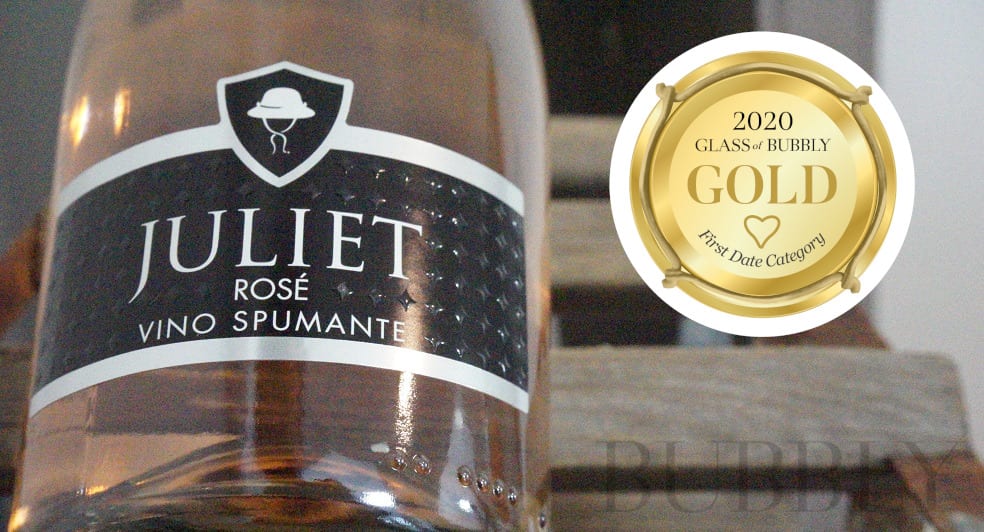
When 3 Cantine Sociali wineries from the Province of Vicenza came together on the 1st of July 2015, Cantine Vitevis was officially born, the cooperative has now more than 2,200 hectares of vineyards, with an annual production of 36 million kilos of grapes and 50.000 tons of wine produced every year.
Cantine Vitevis – Juliet Rosé – Tasting Notes
Aroma – “ A wonderful expression of ripe fruits from peach, strawberries red apples and raspberries on the aroma with a subtle hint of garden foliage.”
A wonderful expression of ripe fruits from peach, strawberries red apples and raspberries on the aroma with a subtle hint of garden foliage.”
Flavour – “ A refreshing array of garden foliage fresh tomatoes, hints of peach and blossom notes on the palate.”
A refreshing array of garden foliage fresh tomatoes, hints of peach and blossom notes on the palate.”
This Italian Sparkling Wine Won a Gold Medal in the First Date Category at the Glass of Bubbly Awards 2020.
4 Villa Franciacorta
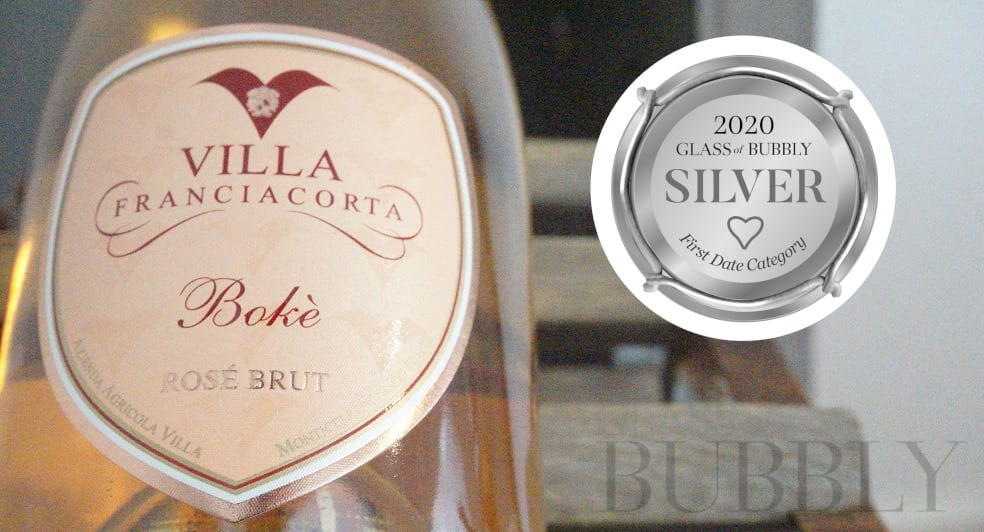
Villa Franciacorta is a small medieval village dating back to the 15th century, it’s located in Monticelli Brusati. The Bianchi family owns the brand and has always produced their wines exclusively with grapes from their 37 hectares of vineyards and then the sparkling wines get aged in their cellar that can rest more than 1,000,000 bottles.
Villa Franciacorta – Bokè Franciacorta Rosé 2014 – Tasting Notes
Aroma – “ Vegetable, earthy, orange blossom and yeasty aromas.”
Vegetable, earthy, orange blossom and yeasty aromas.”
Flavour – “ Citrus, peach, yeasty and pastry on the palate.”
Citrus, peach, yeasty and pastry on the palate.”
This Italian Sparkling Wine Won a Silver Medal in the First Date Category at the Glass of Bubbly Awards 2020.
5 VIN.CO 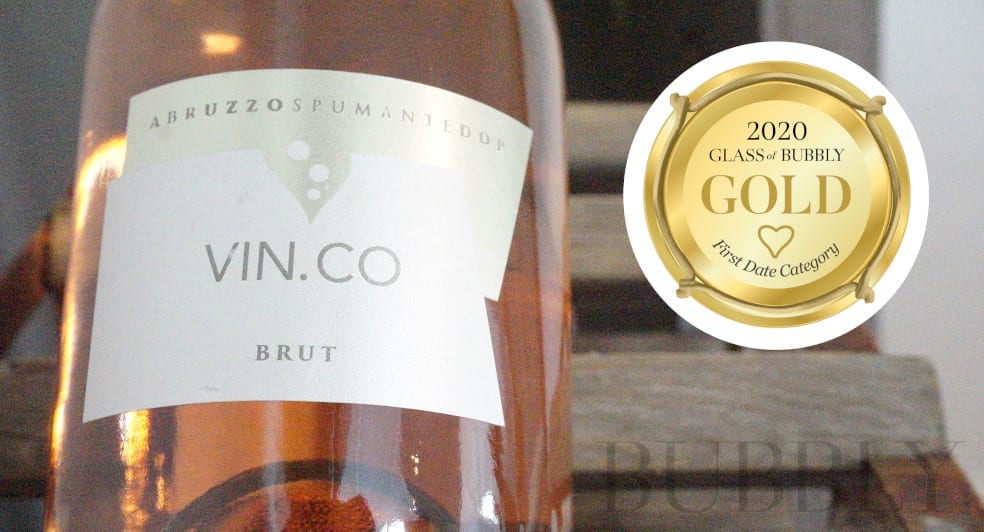
VIN.CO is made in Abruzzo, Italy, their goal is to bottle 5% of the total sparkling wines produced in Abruzzo in less than 5 years. I have enjoyed creating cocktails with VIN.CO’s Sparkling Wines, like this Christmas one: How To Make A Sparkling Snowball Cocktail and this Halloween one: 7 Nights of Horror – Night 1 – Saw
VIN.CO – Abruzzo Spumante DOP Rosé Brut – Tasting Notes
Aroma – “ Peach, pink floral and herbaceous on the aroma.”
Peach, pink floral and herbaceous on the aroma.”
Flavour – “ Peach and orange blossom on the flavour.”
Peach and orange blossom on the flavour.”
This Italian Sparkling Wine Won a Gold Medal in the First Date Category at the Glass of Bubbly Awards 2020.
]]>Instead, this Ferrari brand are the leading producer of sparkling Trentodoc wine, the official toast of Formula 1® racing for the next three years.
Traditionally, Champagne brands have sponsored – and been joyously sprayed around – podium celebrations, but March 2021 saw a move to Italian sparkling wine. One of less fame than Prosecco and Asti, but one of exceptional quality.
What is Trentodoc?

Trentodoc is a sparkling wine produced in the mountainous Trentino region of northern Italy. ‘Trento’ is the main town, and ‘Trentodoc’ designates the region and rules for production of this wine to assure quality.
Unlike Prosecco and Asti, Trentodoc is made using the intricate ‘traditional’ method (aka ‘Metodo Classico’), whereby the second fermentation – the one that adds the sparkle – happens in the bottle through the addition of a yeast, wine and sugar combination called Liqueur de tirage. This method is famously employed in Champagne.
In fact, Trentodoc sparkling wine has much more in common with Champagne than it does its Italian counterparts. Another similarity is the grapes used. Chardonnay is the most popular, but Pinot Noir, Pinot Blanc and Meunier are also permitted.
It is claimed the late Giulio Ferrari, who established Ferrari Trento, was the first Italian producer to make wine this way back in 1902 after his time in Champagne. There are now over 50 producers of Trentodoc, but only a few dominate production with Ferrari roaring ahead in first place.
Traditional method Italian sparkling wines (like Trentodoc and Franciacorta) have not yet replicated the success other Italian bubbles have had outside of Italy (tank-fermented Prosecco takes pole position there). Perhaps the Formula 1® sponsorship could be the key to getting things on track…
For tasting notes on the Ferrari range see Ferrari Trento – “A Dream is all you Need” | Glass Of Bubbly

Written by Kirsty Woodgate DipWSET
WSET Diploma graduate and experienced communications professional.
Judges were:
Patricia Stefanowicz MW
Abbie Bennington DipWSET
Kirsty Woodgate DipWSET
Luciana Girotto
Christopher Walkey
Blind tasting took place at the Glass of Bubbly tasting ‘green’ room where pouring service was provided by Oliver Walkey. All scores were checked live and awards results announced live. The top three rosé sparkling wines were:
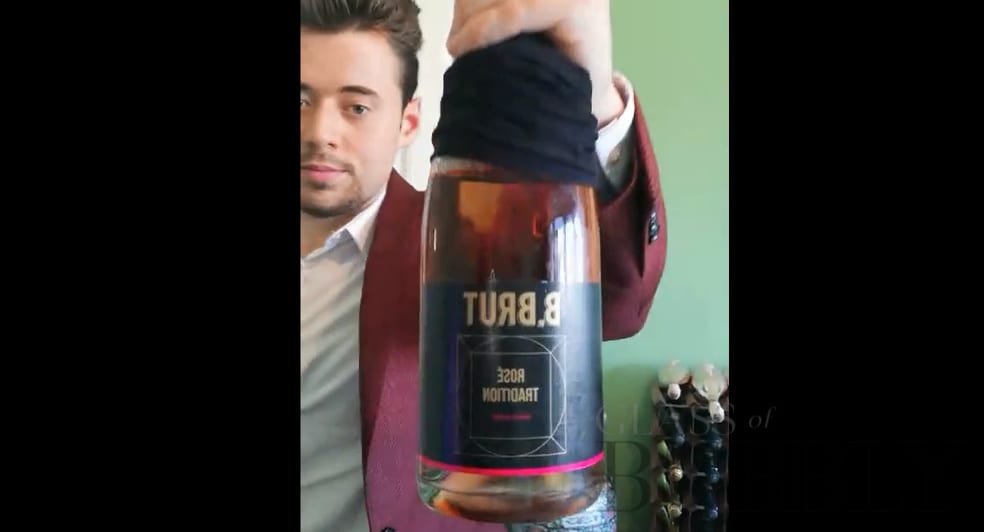
Unveiling of 2021 50 Shades of Rosé (Top Rosé Sparkling Wine) Winner
1st Place: B.Brut Rosé (Luxembourg)
2nd Place: Vin.CO Spumante Rosé Extra Dry (Italy)
3rd Place: Champagne de Watere Rosé Brut (France)
Winery – Wine Label – 1 x judging tasting notes – Full list of entries and live link back to the wines so you can find out more:
B.Brut – Rosé “Caramel, raspberry, peach, wild strawberry aromas. Flavours consist of a good balance of fruits and toasty notes.” Kirsty Woodgate
VIN.CO – Spumante Rosé Extra Dry “Pale pink / baby pink. Small bubbles. Very delicate, floral, lovely aromatic. Flavours are red fruits, hazelnut, peach, very zesty acidity, light body, good definition and length. Savoury finish.” Patricia Stefanowicz MW
Champagne De Watère – Premier Cru Brut Rosé de Saignée “Violet, aromatic, orange blossom, red fruits on the nose. Red fruits, touch dry, pink floral.” Christopher Walkey
Champagne Chateau de Boursault – Rosé Saignée “Strawberry, red currents, raspberries – No bitterness in length.” Abbie Bennington
Champagne PHAL B. de BEAUFORT – Cuvée Harmonie Bouzy Grand Cru Rosé 2012 “Charming Vegetal mousse. Tomato leaf, red berries, long finish.” Luciana Girotto
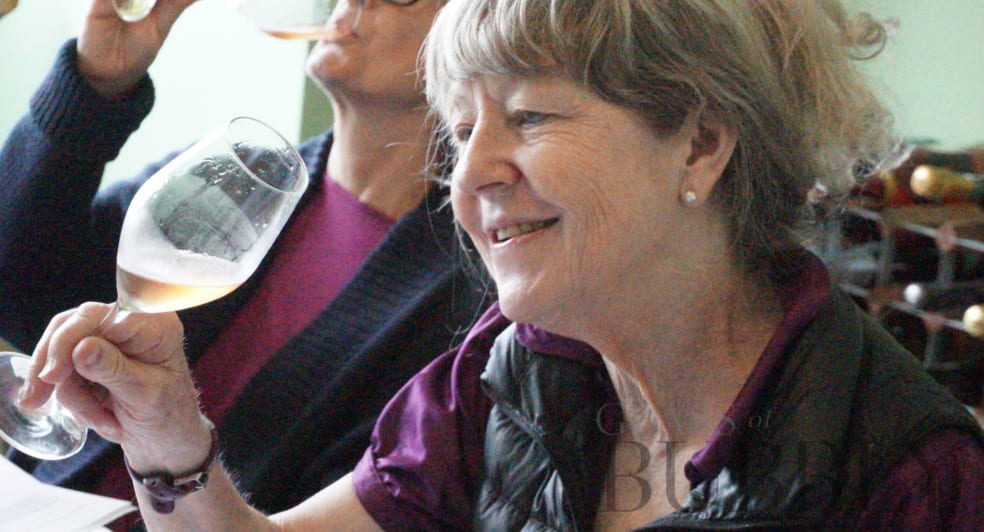
Patricia Stefanowicz MW
Codice Citra – Primae Lucis Brut Rosé “Damp cellar, lemon peel and peachy yeast aromas. Peach, strawberry, pastry flavours.” Christopher Walkey
Schlumberger – Rosé Brut Klassik “Strawberry and cream, touch of cranberry lemon light mousse. Long finish.” Kirsty Woodgate
Pisoni Rosé – Millesimato Trentodoc “Mid salmon colouring, mid sized bubbles. Red fruits, light yeast on nose. Balanced, lively acidity, light body, gentle creamy mousse, longish finish. Elegant garden party style.” Patricia Stefanowicz MW
Posestvo Čehovin – Penina Rose “Delicate nose. Deep pink colour. Rough texture. Ripe, sweet berries, fruit tart with long strong fresh length.” Luciana Girotto
Villa Franciacorta – Bokè Franciacorta Rosé Brut Millesimato 2014 “Vegetal, soft red berry fruits on the nose. Soft flavours of dry toast, dry cheese and subtle red fruit hints.” Christopher Walkey
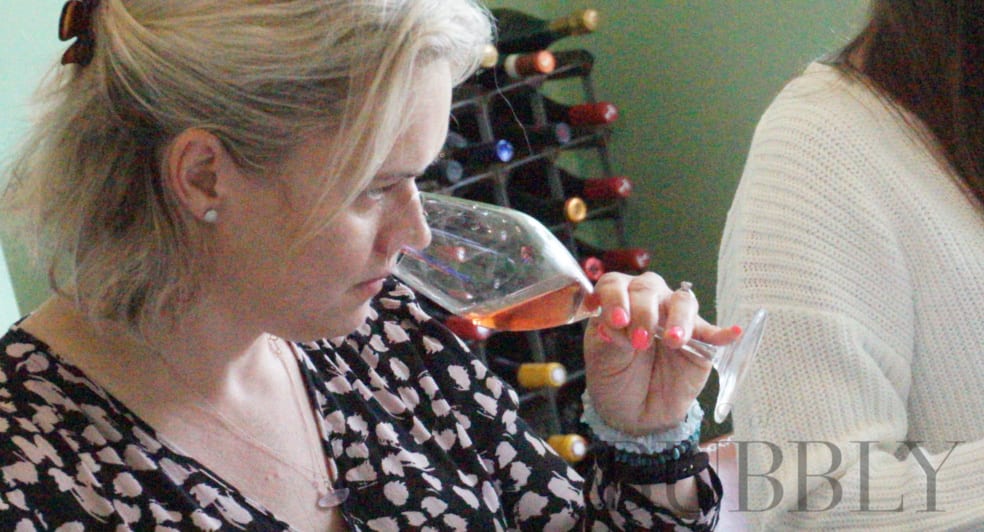
Abbie Bennington
Durnberg – Sparkling Rosé “Very pale Provencal pink. Red fruits on palate, fresh, vibrant finish. Enjoyable and not too sweet.” Abbie Bennington
Ca d’Or – Franciacorta Docg Noble Rosé “Hint of peach, small bubbles, crushed strawberry, plenty of croissant. Lively acidity, creamy mousse, mid-weight, depth and concentration and good length.” Patricia Stefanowicz MW
Champagne Laurent Lequart – Blanche Andésyne Rosé “Strawberry, cranberry, raspberry, baked apple and tar on the nose. Apple pie, almond and hazelnut flavours.” Kirsty Woodgate
Champagne Vollereaux – Cuvée Marguerite rosé 2012 “Dry bread, citrus, lively green fruits, long and savoury finish.” Luciana Girotto
Champagne Faniel & Fils – Rosé Perlane “Dark pink. Medium intensity. Red fruits, nectarine. Punchy on the palate.” Abbie Bennington
Fox & Fox – Expression Rosé Brut 2014 “Peach and pink floral nose with a delicate creamy layer added. Orange blossom, raspberry, herbaceous, tomato leaves and orange zest in the palate.” Christopher Walkey
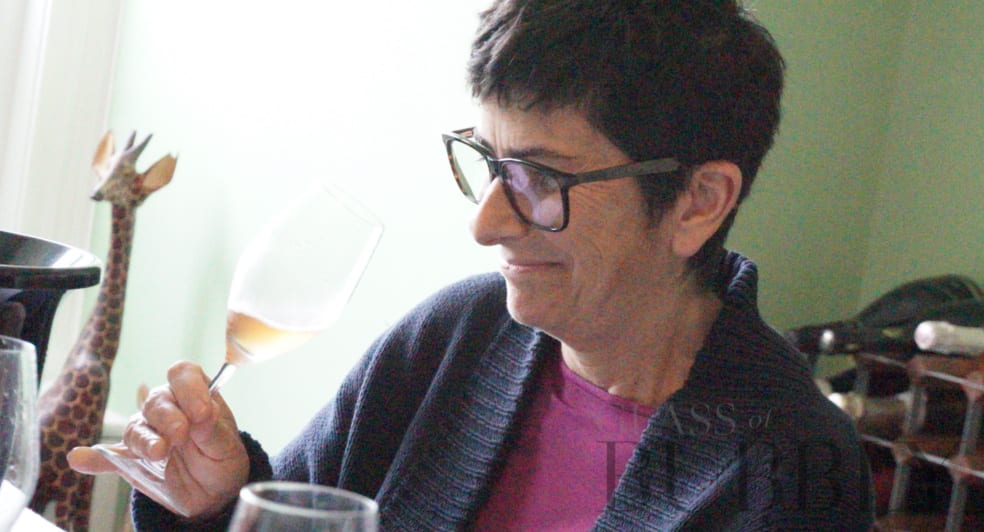
Luciana Girotto
Johann Kattus – Kattus Cuvée Rosé “Pale baby pink. Really herbaceous, grassy, under ripe strawberry, crisp acidity, light body. Attractive fruits, but a little simple. Savoury finish.” Patricia Stefanowicz MW
Badagoni – Rosé “Gorgeous orange / pink colour. Smoky, red cherry, sweet pineapple, sugars, burnt caramel and toffee aromas Roasted fruits and creamy flavours.” Kirsty Woodgate
Rodica – Brut Rosé “Mid-mild salmon pink colour. Large bubbles. A little murky. Smoky, earthy, orange zest, spices. Fair acidity, average length. Odd style.” Patricia Stefanowicz MW
Fitz – Pink “Intense colour. Intense syrup as per Kir Royale. Spicy. Round big bubbles. Long finish. Classic.” Luciana Girotto
Champagne Roger Brun – Romance “Creamy raspberry and strawberry on the nose. Red berries, red apples, strawberry with a touch of toasted creamy in flavours.” Christopher Walkey
Riva Dei Frati – Claudia Rosé “Mid salmon in colour. Under ripe stone fruits on the nose. Red fruits on the palate.” Abbie Bennington
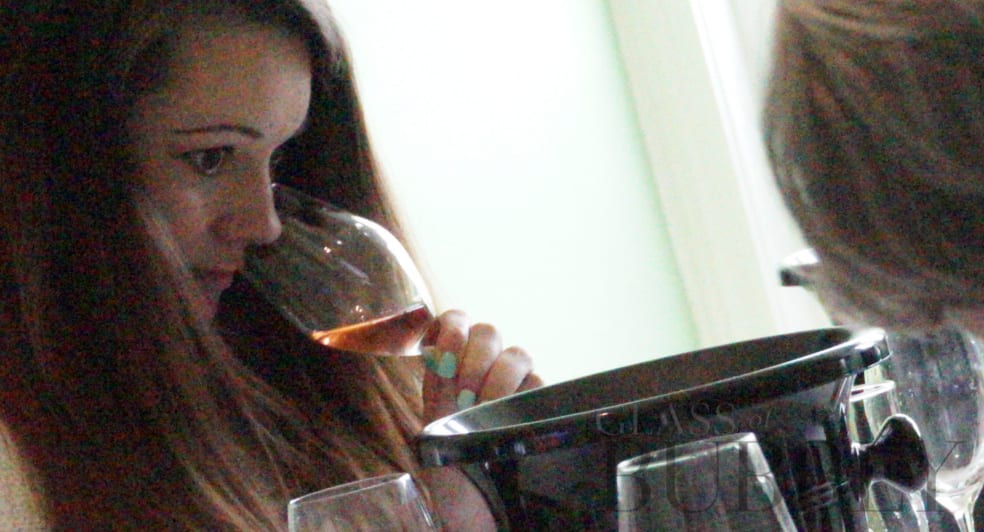
Kirsty Woodgate
Kmečka Zadruga Krško – Cesarska “Roasted coffee, nectarine – low intensity flavours. Quite high acidity.” Kirsty Woodgate
Johanneshof Reinisch – Pinot Noir Brut Reserve 2014 BIO “Creamy light red fruits, yeasty, soft citrus on the nose. Red berry fruits, minerals, good acidity, steely length.” Christopher Walkey
Vinska klet Frelih – Rosé Brut “Creamy strawberry on the nose and on the palate too. Vegetal also.” Luciana Girotto
Silveri – Cuvee Brut Rose “Butter, smoke, cream, smooth. Very palatable and pleasing.” Kirsty Woodgate
VIN.CO – Abruzzo Spumante DOP Rosé Brut “Very pale pink. Strawberry, raspberry. Gentle yeast. Nicely balanced with acidity, light body – A good summer wine.” Patricia Stefanowicz MW
Radgonske Gorice – Penina Rose extra dry “Pale, mid-onion skin colour. Slight biscuit / brioche nose. Apricot juice, lemon sherbert, blue cheese flavours.” Abbie Bennington
Vinarstvo Rebula – Penina Rosa “Vegetal, herbaceous, tomato leaves on the nose. Tomato leaves, soft raspberry, yeasty / toasty in flavours.” Christopher Walkey
CANTINE VITEVIS – Juliet Rosé “Delicate pink colour. Vegetable garden, stone fruits, tomato leaf. Fine texture. Light and bright.” Luciana Girotto
Arunda – Brut Excellor “Pale peach colour with persistent bubbles. Lovely red fruits, some autolysis, juicy fruits on the palate. High acidity, brittle mousse giving structure. Complexity and length.” Patricia Stefanowicz MW
Bjana – Brut Rosé 2015 “Saline, salty sea, ocean breeze. Perfect for a trip to the beach! Pears nectarine, peach flavours. Delicate. Added apples (stewed) and quince. Lacking slightly in fizz.” Kirsty Woodgate
Kmečka zadruga Krško – Rosé “Cherryade style in the glass visually. Red cherry, red currant and grapey / tannins in the finish.” Abbie Bennington

Christopher Walkey
Kartuzija Pleterje – Resslova Penina “Dark fruits, undergrowth, soft raspberry nose. Red fruits, peach and fresh bread in flavours.” Christopher Walkey
Camel Valley – 2018 Pinot Noir Rose Brut “Citrus notes, light jasmine, leafy, candy on the hose. Off dry in the beginning with light, leafy palate. Well done, classical style.” Luciana Girotto
Maso Martis – Rosé Extra Brut 2016 “Pale peach, small bubbles. Red berries, quite yeasty and herbal notes on the nose. Mid weight, lemon zest, creamy mousse with a savoury finish.” Patricia Stefanowicz MW
Radgonske Gorice – Penina Rose Selection brut “Peach, apricot, fetta cheese / yeasty nose. Pleasant fruitiness with good acidity / peach skin.” Christopher Walkey
Ventiventi – Rosé Lambrusco Rosato Modena DOC “Frothy, slightly reductive nose – smoke, flint, lemon. Nectarine, apples, sourdough crust flavours.” Kirsty Woodgate
La Montina – Franciacorta Rosé Extra Brut “Pale pink, lazy bubbles, raspberry, gentle yeast, off dry. Light body, creamy mousse, juicy, good freshness, nice balance, fair length.” Patricia Stefanowicz MW
Medot – Brut Rosé “Classic sparkling rosé style. Strawberry, light autolysis, straight done the middle.” Kirsty Woodgate
Karlovcek Jernejeva – Penina rose “Fruit salad, jelly raspberry. Rounded sweet nose almondy.” Luciana Girotto
Lumiere – Rosé 2017 “Pale delicate aromas. Red currant, cranberry, raspberry, sherbert finish with apple, pear – Light character flavours. Medium acidity. Medium length.” Abbie Bennington
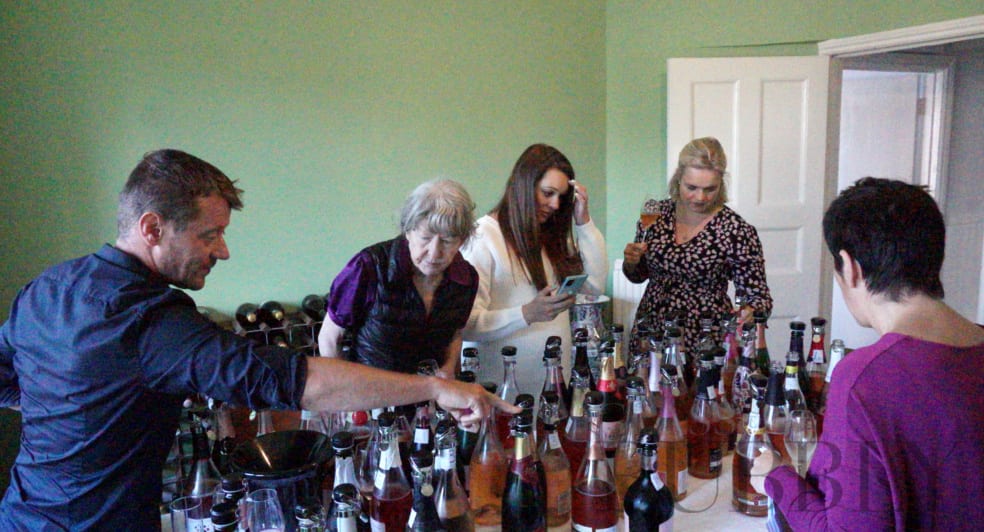
50 Shades of Rosé 2021 – The aftermath
Szigeti – Pinot Noir Rosé Brut “Candy, red fruits including raspberry, pink floral aromas. Easy to enjoy flavours of soft red berry fruits.” Christopher Walkey
Domacija Pr Cenetovih – Penina Rose “Mid cherry colour. Cherry, raspberry, vibrant fruits, earthy, smoky – very fizzy. Slight tannins, fresh acidity, creamy, fair length.” Patricia Stefanowicz MW
CANTINE VITEVIS – BARDOLINO CHIARETTO DOC (rosé) “Ripe nectarine, honeysuckle, blood orange, light edge of pastry with sweet jam covering thinly on top.” Kirsty Woodgate
Poulton Hill Vineyard – Bulari Rosé 2015 “Mid Provencal pink colour. Red fruits, red cherries, redcurrant, nettles, sweet pea, elderflower on the palate. Dry with medium acidity style. Gooseberry, medium plus finish.” Abbie Bennington
Champagne Robert Allait – Cuvée Eclat de Meunier (Rosé de Saignee) “Soft almond, raspberry, meringue aromas. Nice expression of red berry fruits, dried strawberry with good levels of acidity. An attractive warm deeper rosé colouring.” Christopher Walkey
Zantho – Cuvée Rosé “Very pale peach, tight bubbles. White peach, floral, red berries, juicy, vibrant acidity. Light body, creamy mousse texture, nicely defined. Fair length. A little on the sweeter side.” Patricia Stefanowicz MW
Martincic – Penina Rose “Sulphur/reductive nose. Crust and crumble, strawberry crumble and redcurrant. Light intensity flavours.” Kirsty Woodgate
Motzenbacker – Rosé Brut “Salmon pink colour. White flowers, almond after taste – creamy texture. Little short in length. Nettles at the close.” Luciana Girotto
Weingut Muller-Grossman – Brut Rosé Reserve “Deep pink. Effervescent bubbles, persistent. High acidity, med intensity, strawberries, red cherries, red currant. Flavours as per nose with added yeast, biscuit and brioche.” Abbie Bennington
Cavas Naveran – Perles Roses “Peach, touch of petroleum, yeast on the nose. Soft pink rose petals, light red fruits, touch of red candy sweets.” Christopher Walkey
Schlumberger – Pinot Noir Brut 2015 “Pear, grape – quite simple flavours. White blossom, floral nose. Lacking complexity.” Kirsty Woodgate
Jože Bevec – Barbara Brut Rosé “Mid cherry colour, small bubbles. Mushroom, restrained, soft fruits, creamy, meringue, candied. Mid weight, modest length – not very typical style!” Patricia Stefanowicz MW
Bibich Winery – Rose Brut “Flat cola, Lucozade, botanical aromas. Dry meditional flavours with added orange blossom, orange peel and faint cherry.” Christopher Walkey
Vinarstvo Valdhuber – Rosé Extra Brut “Light intensity on the nose with sherbet character. Low intensity in flavour, a touch bitter.” Kirsty Woodgate
Vilarnau – Rose (Refused / corked)
The scoring and awards announcements for the 2021 50 Shades of Rosé awards were broadcast live via Instagram here:
* How to enter the 50 Shades of Rosé sparkling wine awards? It’s totally free if you enter ‘The Glass of Bubbly Awards’ – Find out more by emailing [email protected] or visiting our awards page here.
]]>“Sparkling rosé wine will mostly gain their shades of pink via skin contact of black grapes or by adding a small percentage of still red wine. Depending on the wine production method and the end results required, rosé sparkling wines can take on not only many different shades, but also offer a variety of tasting experiences.” source GlassofBubbly
Seen also as very versatile when pairing with foods and depending on sugar levels, rosés are great with desserts along with spicy dishes.
Rosé sparkling wines can take many variations and styles, from sweeter (extra dry) styles of non complicated aromas and flavours to those aged and complex dry options. From Champagne to Japan, rosé sparkling wines are a popular option for buyers and most wineries producing bubbles will usually have at least one rosé label on offer.
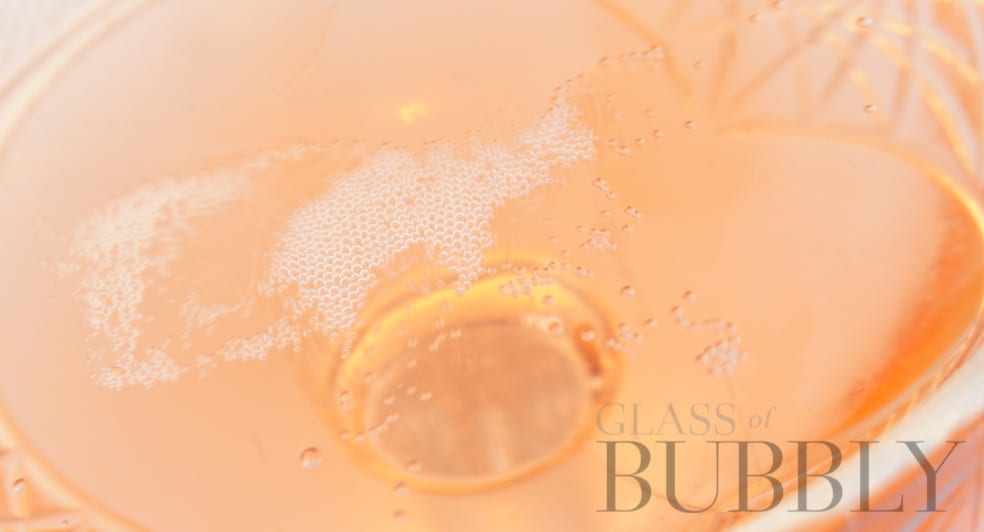
Rosé Sparkling Wines can take all different shades of colour from light pink to darker orange and beyond…
For this article I wanted to look at 5 rosés from 5 countries which are:
Italy (Franciacorta)
Slovenia
Croatia
Austria
Luxembourg
Europe is a wonderful place to start for sparkling wines, indeed there is almost a lifetime of explorations to discover and enjoy. Characteristics change as terroirs alter between regions / countries / degree of latitude. Winemaking styles also vary and of course so do the grapes.
I simply pulled out 5 rosé sparkling wines from our section of 2020 award winners making sure I chose a single option from random European countries. Many of course will say that the likes of European powerhouse wine producing countries are the best (old world) such as France, Italy and Germany to name a few.
What is Rosé de Saignée?
“Saignée: A less common process is the saignée method which translates to English as ‘bleeding’ method. A more labour intensive way to produce rosé Champagne in that the colour from the skins of the red grapes during the pressing is released into the blend. The longer the skin contact is the darker the Champagne will become. Usually, a rosé de saignée Champagne will be a darker shade over the assemblage options.” source GlassofBubbly
I decided to leave out France (Champagne) and also Prosecco (Rosé) for this article and tasting so we can take a look at lesser known rosé sparkling wine countries and styles:
ITALY (Franciacorta) – Ca’ d’Or DOCG Noble Rosé: “Aromas of dark berry fruits, near ripe blackberry mostly. Taste is lighter in style showing a toasty red berry fruit character with damson. Fresh and clean.”
SLOVENIA – Kmečka Zadruga Krško Cesarska Penina (Method Charmat)Polsuho: “Deep red berries expression on the nose. Ripe red berries, touch of cream cheese and red apple in flavours – Sweeter style though delivered elegantly in the palate.”
CROATIA – Bibich Brut Rosé: “An orange tart, tangerine skin, menthol on the nose – almost Lucozade style. Dry flavours of orange, spices, peach skin and much more.”
AUSTRIA – Muller Grossman Brut Rosé Reserve: “Light expression of red berries and wild strawberry on the nose. Served well chilled at 6°C and it was most refreshing. Red berries and faint ripe strawberries in flavours with a mouth-watering dryness in mid length to close. Ideal for spicy food pairings such as BBQ meats and curries.”
LUXEMBOURG – B.Brut Rosé Tradition: “A fresh red berry fruit expression on the nose with hints of petroleum. Flavours are initially dry red berries and opens in mid length to be slightly more rounded / sweeter.“
]]>“Terroir is a French term used to describe the environmental factors that affect a crop’s phenotype, including unique environment contexts, farming practices and a crop’s specific growth habitat. Collectively, these contextual characteristics are said to have a character; terroir also refers to this character.” Wikipedia
Personally, I like to refer to ‘terroir’ as the sense of the place, this is all made much easier to understand when you have visited either the region the wine is from or to be even more precise, the winery itself. Where the vines were grown in order to make the wine from each vine itself to the land it sits on, down through the soil layers and up through the atmosphere with wind, rain and sunshine thrown in and a little help from man. From Alpine freshness to volcanic soils, hot summers to frosty mornings – So much goes into each terroir we get to experience within our favourite wines.
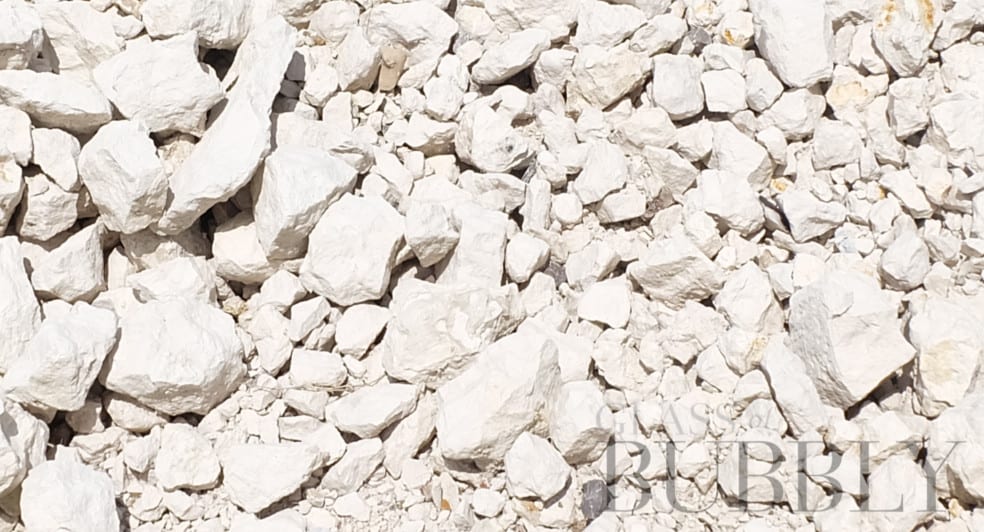
Chalk and Stoney character land
Many people, assume or heavily focus on, that terroir refers to the soil and how it’s expression is shown within the wine. Such is the variation in opinions of the meaning of terroir that we can safely say that the land/soil is a prominent feature and certainly holds much influence on the end results in winemaking. Many wines express very well the style of the soil they are produced on with many references expressed as wine professionals write down their tasting notes (aromas and flavours). There is again much debate still as to whether the soil affects the wine or contributes value in flavour to the wine – Soil also must be seen as not just the top level, visible surface, but what lies beneath and what the vine routes feed from.
Soil types vary tremendously from chalk to clay, volcanic to the darker type that many of us will have in our back gardens and constantly dig over to get that proud line of runner beans each year. The soil will influence what type of vine grows best and also the outcome of grape colour / tannins / acidity and more. There must be some kind of magic that soil / land offers in wine production as many single vineyards globally are picked out as being extra special and producing the world’s most prestigious and highly valued wines.
“Krug ‘Clos du Mesnil’ is from a 1.4ha vineyard in the shadow of the church at Mesnil-sur-Oger and seems to enjoy something of a premium above and beyond normal comprehension.” source Glassofbubbly
Though much research takes place on the subject of soil and wine, there is not much clarification to refer to and only plenty of opinions to digest.
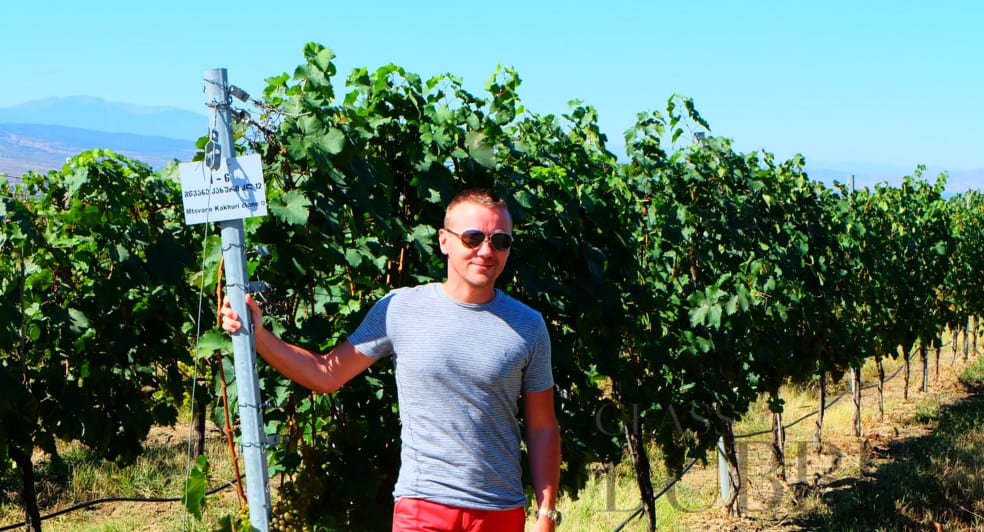
Cool, Warm and Hot weather effect Wine Character – Here I am in Georgia
The weather is also an important key in wine production. Without its influence, there would be no wine. Just like we learn as children that fire requires three components in order to survive (heat, oxygen and fuel), one of the components for wine is the weather which blesses the vines each day with its presence.
The global wine production takes places within two hemispheres that mostly lay within the 30th and the 50th degree of latitude in both the Northern and Southern. Each country and each wine region will offer wide varieties of wines thanks to the grapes of each harvest. With attention to detail, and a long history, we see grapes popular in one region and not so in another as with fine research from experienced wine professionals decides the versatility of and production qualities of each variety so to be maximised. Some grapes fair better in some terroirs over others.
With weather comes temperatures and once again, grapes are very much influenced by the morning frost to the roasting glare from the midday sun. The terroir is expressed and influences the grapes grown and wine produced (certain grape varieties perform better in their most suitable average temperature zone).

Lake Iseo on the edge of the Franciacorta Wine Region
Combining both the land and the weather we will also see water which is another important influence on wine production. Be it from rainfall to the avenues of water sources the roots of the vines find down below and also including the likes of rivers, lakes and the sea. Another big topic here though to summarise, water effects much and not only be feeding the vines – The likes of temperature control, irrigation, morning dew, how it falls from the sky (downpours to include hail) and much more affect the end results of the grapes the vine will produce.
I would also like to throw in the last name in this terroir hat, and this is human engagement within wine production. Another meaty topic with much to explore, though we can say that over the years winemakers will nurture the land their vines grow on. This takes shape in many forms from the likes of air circulation to controlling pests, how the vine is grown and taken care of to sustainability practices and harvesting.
The terroir could also extend to winemaking practices from the usage of oak ageing to the magical blends that have helped to shape the character of the wine over many years.
]]>